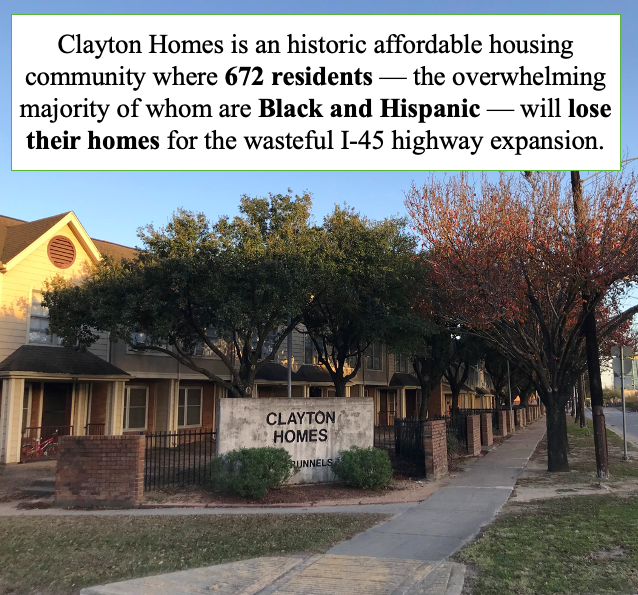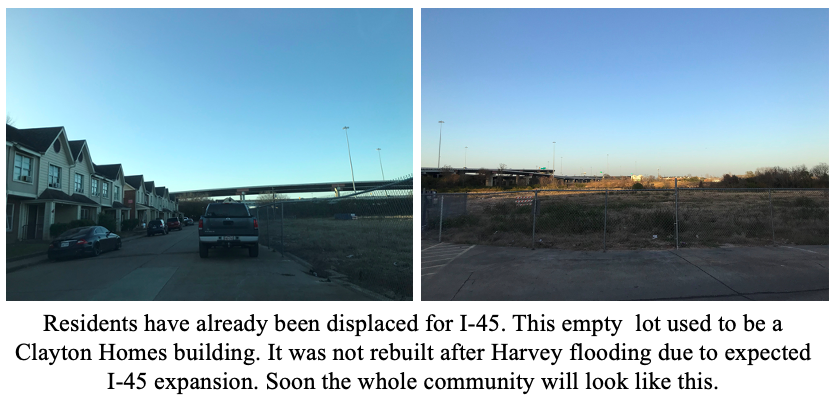 “Everybody is praying,” said Mr. D, motioning with his hand to encompass the Clayton Homes community where he and 671 other residents will lose their homes for the I-45 expansion. Mr. D and his neighbors have heard very little from the authorities about what the promised vouchers will look like or where they will relocate. I was met with confused stares when I asked residents if they knew about moving costs and how to get the most possible reimbursement from the Texas Department of Transportation (TxDOT), the government agency overseeing the project.
“Everybody is praying,” said Mr. D, motioning with his hand to encompass the Clayton Homes community where he and 671 other residents will lose their homes for the I-45 expansion. Mr. D and his neighbors have heard very little from the authorities about what the promised vouchers will look like or where they will relocate. I was met with confused stares when I asked residents if they knew about moving costs and how to get the most possible reimbursement from the Texas Department of Transportation (TxDOT), the government agency overseeing the project.
It is not only bureaucratic barriers and legal insider knowledge barring Houston’s poorest residents from being properly reimbursed for their losses. TxDOT has set aside only 27 million for compensating displaced residents, less than a paltry 0.39 percent of the 7 billion project budget, even though residents in 160 single-family residences and 919 multi-family residential units will be displaced. Houston’s affordable housing shortage will be exacerbated by the seizure of other affordable housing such as Kelly Village, Temenos Place, and Midtown Terrace Suites. Clayton Homes is just one of many communities that will be broken apart for the highway expansion.
 “Everyone’s waiting,” continues Mr. D. “Then they’ll say, ‘Man, they f-ed us over.’” This conclusion is hard to argue with, given TxDOT’s inadequate reimbursement practices. As a leading Houston eminent domain lawyer Justin Hodge explains to me, TxDOT independently assesses the value of your home—often at a far lower value than the cost of a comparable home in Houston’s appreciating housing market. To challenge TxDOT’s assessment, you will need to hire lawyers and expert property assessors, costs most low-income residents cannot afford up-front. Legal costs and reimbursement chances are even worse for undocumented residents. To ensure your full moving costs are reimbursed, you will have to hire an independent state-approved mover, which also involves large up-front sums. And even if you manage to do all this, you will never be compensated for: the lost earnings for the time you spent moving and fighting the state, the loss of community cohesion when your neighbors scatter to different parts of the city (as happened to Mr. D when his previous Clayton Homes building was torn down after Harvey), the trauma of being uprooted, or the burdens of being further from economic opportunities, green spaces, and healthy food outlets.
“Everyone’s waiting,” continues Mr. D. “Then they’ll say, ‘Man, they f-ed us over.’” This conclusion is hard to argue with, given TxDOT’s inadequate reimbursement practices. As a leading Houston eminent domain lawyer Justin Hodge explains to me, TxDOT independently assesses the value of your home—often at a far lower value than the cost of a comparable home in Houston’s appreciating housing market. To challenge TxDOT’s assessment, you will need to hire lawyers and expert property assessors, costs most low-income residents cannot afford up-front. Legal costs and reimbursement chances are even worse for undocumented residents. To ensure your full moving costs are reimbursed, you will have to hire an independent state-approved mover, which also involves large up-front sums. And even if you manage to do all this, you will never be compensated for: the lost earnings for the time you spent moving and fighting the state, the loss of community cohesion when your neighbors scatter to different parts of the city (as happened to Mr. D when his previous Clayton Homes building was torn down after Harvey), the trauma of being uprooted, or the burdens of being further from economic opportunities, green spaces, and healthy food outlets.
The financial and social hardships the expansion will impose on our city’s most vulnerable communities are not limited to those who are literally displaced. As the environmental literary critic Rob Nixon has observed, displacement can also happen in place when, without moving anywhere, you find your surroundings dramatically transformed. Many Houstonians will suddenly find their homes, schools, community centers, and workplaces closer to the highway, and as a result, will face worse air quality, noise pollution, heat island effects, and flooding risks, per Air Alliance Houston’s report.
The air pollution from increased proximity to vehicle emissions will pose great health risks to the community, especially the children at the roughly two dozen schools and a dozen daycares that will fall within 500 feet of the highway. These schools already have some of the highest asthma rates in the country, and greater traffic pollution will bring more asthma and respiratory disease, possibly harm children’s cognitive development, and increase risks of cancer as the traffic pollutants contain known carcinogens. These greater health risks are associated with more days missed in school, more sick days from work, greater medical expenses, and lower quality of life. There is also the pollution from the construction process itself, where petrochemicals, lubricants, and sediment are likely to contaminate water supplies unless TxDOT implements effective safety measures.
The environmental damages and increased health risks of the project primarily affect Houston’s low-income, high minority communities surrounding the proposed expansion (up to 75.5% poverty rate, up to 94% people of color), making the project a textbook case of environmental racism where all the environmental damages of “progress” are dumped on the poorest, highest-minority communities.
And what is all this for? TxDOT promises reduced traffic times, but this projected benefit is highly dubious—unlike the harms of the highway expansion. Similar highway expansion projects have not durably decreased congestion or increased highway safety, according to reporters and economists. “Adding more freeway capacity in urban areas just generates additional driving, longer trips and more sprawl; and new lanes are jammed to capacity almost as soon as they’re open,” writes Joe Cortright. Surely the 7 billion dollars could be better spent investing in public transport, schools, affordable housing, or Medicaid.
Nevertheless, federal approval for the project is likely to come in the next few months. Until then, community members remain active through public input meetings and canvassing to inform affected communities. Here is how you can help:
- You can demand better environmental safety measures and compensation from the I-45 expansion at upcoming Transportation Policy Council meetings. Ask for TxDOT to set aside more funds for compensating displacees, invest in public transport instead of highway expansion, increase funding for high quality air filters, increase the locations of air monitoring, and use pollution standards that research has linked to negative outcomes instead of using inadequate national standards.
- If your family or organization will be forced to relocate, you can add your email to this mailing list so that you can receive free resources on navigating relocation and TxDOT compensation, such as an upcoming webinar with eminent domain lawyer Justin Hodge.
- If you would like to donate to relocation expenses, please add your email to this mailing list so that you can be notified of funds that open for assisting residents affected by I-45 expansion.
Next month’s installment of this series on environmental injustice and the I-45 expansion will focus on the NGOs, community centers, and business serving people of color that will be damaged by the project.
Author and Photos: Anna Kasradze